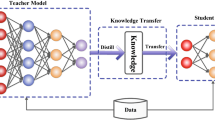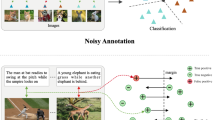Abstract
Unsupervised Domain Adaptation (UDA) aims to transfer knowledge from a label-rich source domain to an unlabeled target domain with a different but related distribution. Optimal Transport (OT) based Wasserstein distance has recently been used to measure and reduce the domain discrepancy in virtue of its robustness in distance measurement. However, the inaccurate estimation of the transport cost between samples is harmful to the fine-grained domain alignment. This paper proposes Decomposed-Distance Weighted Optimal Transport (DDW-OT) method for better adaptation. Technically, according to the clustering-based prototype generation (CPG), DDW-OT constructs a decomposed-distance reweighing matrix to revise the original inaccurate transport distance on sample-level, which conjoins the category uncertainty of the target samples and the correlation degree of category between domains. Besides, the dual-OT solver takes neural netw11 orks to parameterize the dual variables and alleviate the computation cost. DDW-OT also allocated an explicit class-conditional alignment strategy to enhance transfer performance. Extensive experiments on benchmarks demonstrate the effectiveness of the proposed method.








Similar content being viewed by others
References
Ajakan H, Germain P, Larochelle H, Laviolette F, Marchand M (2014) Domain-adversarial neural networks. arXiv:1412.4446
Arjovsky M, Chintala S, Bottou L (2017) Wasserstein gan
Asad M, Jiang H, Yang J, Tu E, Malik AA (2021) Multi-stream 3d latent feature clustering for abnormality detection in videos. Appl Intell pp 1–18
Aude G, Cuturi M, Peyré G, Bach F (2016) Stochastic optimization for large-scale optimal transport. arXiv:1605.08527
Ben-David S, Blitzer J, Crammer K, Kulesza A, Pereira F, Vaughan JW (2010) A theory of learning from different domains. Machine Learning 79(1):151–175
Ben-David S, Blitzer J, Crammer K, Pereira F, et al. (2007) Analysis of representations for domain adaptation. Advances in Neural Information Processing Systems 19:137
Blondel M, Seguy V, Rolet A (2018) Smooth and sparse optimal transport. In: International conference on artificial intelligence and statistics. PMLR, pp 880–889
Chen C, Chen Z, Jiang B, Jin X (2019) Joint domain alignment and discriminative feature learning for unsupervised deep domain adaptation. In: Proceedings of the AAAI conference on artificial intelligence, vol 33, pp 3296–3303
Chen C, Xie W, Huang W, Rong Y, Ding X, Huang Y, Xu T, Huang J (2019) Progressive feature alignment for unsupervised domain adaptation. In: Proceedings of the IEEE/CVF conference on computer vision and pattern recognition, pp 627–636
Courty N, Flamary R, Tuia D, Rakotomamonjy A (2017) Optimal transport for domain adaptation. IEEE Transactions on Pattern Analysis and Machine Intelligence 39(9):1853–1865. https://doi.org/10.1109/TPAMI.2016.2615921
Cuturi M (2013) Sinkhorn distances: lightspeed computation of optimal transport. In: NIPS, vol 2, p 4
Damodaran BB, Kellenberger B, Flamary R, Tuia D, Courty N (2018) Deepjdot: Deep joint distribution optimal transport for unsupervised domain adaptation. In: Proceedings of the european conference on computer vision (ECCV), pp 447–463
Deng Z, Luo Y, Zhu J (2019) Cluster alignment with a teacher for unsupervised domain adaptation. In: Proceedings of the IEEE/CVF international conference on computer vision, pp 9944–9953
Gao B, Yang Y, Gouk H, Hospedales TM (2020) Deep clustering for domain adaptation. In: ICASSP 2020-2020 IEEE International conference on acoustics, speech and signal processing (ICASSP). IEEE, pp 4247–4251
Ghifary M, Kleijn WB, Zhang M, Balduzzi D, Li W (2016) Deep reconstruction-classification networks for unsupervised domain adaptation. In: European conference on computer vision. Springer, pp 597–613
Gholenji E, Tahmoresnezhad J (2020) Joint discriminative subspace and distribution adaptation for unsupervised domain adaptation. Appl Intell 50(7):2050–2066
Hartigan JA, Wong MA (1979) A k-means clustering algorithm. Appl Stat 28(1)
He K, Zhang X, Ren S, Sun J (2016) Deep residual learning for image recognition. In: Proceedings of the IEEE conference on computer vision and pattern recognition, pp 770–778
Hinton G, Vinyals O, Dean J (2015) Distilling the knowledge in a neural network. Comput Sci 14(7):38–39
Hu C, He S, Wang Y (2021) A classification method to detect faults in a rotating machinery based on kernelled support tensor machine and multilinear principal component analysis. Appl Intell 51 (4):2609–2621
Hu C, Wang Y, Gu J (2020) Cross-domain intelligent fault classification of bearings based on tensor-aligned invariant subspace learning and two-dimensional convolutional neural networks. Knowl-Based Syst 209:106214
Jiang X, Lao Q, Matwin S, Havaei M (2020) Implicit class-conditioned domain alignment for unsupervised domain adaptation. In: International conference on machine learning. PMLR, pp 4816–4827
Kang G, Jiang L, Yang Y, Hauptmann AG (2019) Contrastive adaptation network for unsupervised domain adaptation. In: Proceedings of the IEEE/CVF conference on computer vision and pattern recognition, pp 4893–4902
Kantorovich L (1942) On the transfer of masses (in russian). In: Doklady akademii nauk, vol 37, pp 227–229
Kerdoncuff T, Emonet R, Sebban M (2020) Metric learning in optimal transport for domain adaptation
Li M, Zhai YM, Luo YW, Ge PF, Ren CX (2020) Enhanced transport distance for unsupervised domain adaptation. In: Proceedings of the IEEE/CVF conference on computer vision and pattern recognition, pp 13936–13944
Liakos KG, Busato P, Moshou D, Pearson S, Bochtis D (2018) Machine learning in agriculture: a review. Sensors 18(8):2674
Long M, Cao Y, Wang J, Jordan M (2015) Learning transferable features with deep adaptation networks. In: International conference on machine learning. PMLR, pp 97–105
Long M, Cao Z, Wang J, Jordan MI (2017) Conditional adversarial domain adaptation. arXiv:1705.10667
Long M, Wang J, Ding G, Sun J, Yu PS (2014) Transfer joint matching for unsupervised domain adaptation. In: Proceedings of the IEEE conference on computer vision and pattern recognition, pp 1410–1417
Long M, Zhu H, Wang J, Jordan MI (2017) Deep transfer learning with joint adaptation networks. In: International conference on machine learning. PMLR, pp 2208–2217
Van der Maaten L, Hinton G (2008) Visualizing data using t-sne. J Mach Learn Rese 9(11)
Maxwell AE, Warner TA, Fang F (2018) Implementation of machine-learning classification in remote sensing: an applied review. Int J Remote Sens 39(9):2784–2817
Munkres J (1962) Algorithms for the assignment and transportation problems. SIAM J, 10
Pan Y, Yao T, Li Y, Wang Y, Ngo CW, Mei T (2019) Transferrable prototypical networks for unsupervised domain adaptation. In: Proceedings of the IEEE/CVF conference on computer vision and pattern recognition, pp 2239–2247
Perrot M, Courty N, Flamary R, Habrard A (2016) Mapping estimation for discrete optimal transport. In: Proceedings of the 30th international conference on neural information processing systems, pp 4204–4212
Peyré G., Cuturi M, et al. (2019) Computational optimal transport: With applications to data science. Foundations and Trends® in Machine Learning 11(5-6):355–607
Redko I, Habrard A, Sebban M (2017) Theoretical analysis of domain adaptation with optimal transport. In: Joint european conference on machine learning and knowledge discovery in databases. Springer, pp 737–753
Russakovsky O, Deng J, Su H, Krause J, Satheesh S, Ma S, Huang Z, Karpathy A, Khosla A, Bernstein M (2015) Imagenet large scale visual recognition challenge. Int J Comput Vis 115 (3):211–252
Saenko K, Kulis B, Fritz M, Darrell T (2010) Adapting visual category models to new domains. In: European conference on computer vision. Springer, pp 213–226
Saito K, Watanabe K, Ushiku Y, Harada T (2018) Maximum classifier discrepancy for unsupervised domain adaptation. In: Proceedings of the IEEE conference on computer vision and pattern recognition, pp 3723–3732
Sankaranarayanan S, Balaji Y, Castillo CD, Chellappa R (2018) Generate to adapt: Aligning domains using generative adversarial networks. In: Proceedings of the IEEE conference on computer vision and pattern recognition, pp 8503–8512
Seguy V, Damodaran BB, Flamary R, Courty N, Rolet A, Blondel M (2018) Large-scale optimal transport and mapping estimation. In: ICLR 2018-International conference on learning representations, pp 1–15
Shen J, Qu Y, Zhang W, Yu Y (2018) Wasserstein distance guided representation learning for domain adaptation. In: Proceedings of the AAAI Conference on Artificial Intelligence, vol. 32
Song L, Wang C, Zhang L, Du B, Zhang Q, Huang C, Wang X (2020) Unsupervised domain adaptive re-identification: theory and practice. Pattern Recogn 102:107173
Sun B, Saenko K (2016) Deep coral: Correlation alignment for deep domain adaptation. In: European conference on computer vision. Springer, pp 443–450
Tzeng E, Hoffman J, Saenko K, Darrell T (2017) Adversarial discriminative domain adaptation. In: Proceedings of the IEEE conference on computer vision and pattern recognition, pp 7167–7176
Tzeng E, Hoffman J, Zhang N, Saenko K, Darrell T (2014) Deep domain confusion: Maximizing for domain invariance. arXiv:1412.3474
Venkateswara H, Eusebio J, Chakraborty S, Panchanathan S (2017) Deep hashing network for unsupervised domain adaptation. In: Proceedings of the IEEE conference on computer vision and pattern recognition, pp 5018–5027
Wang Y, Ye H, Cao F (2021) A novel multi-discriminator deep network for image segmentation. Appl Intell (12)
Xiao N, Zhang L (2021) Dynamic weighted learning for unsupervised domain adaptation. In: Proceedings of the IEEE/CVF conference on computer vision and pattern recognition, pp 15242–15251
Xu R, Liu P, Wang L, Chen C, Wang J (2020) Reliable weighted optimal transport for unsupervised domain adaptation. In: Proceedings of the IEEE/CVF conference on computer vision and pattern recognition, pp 4394–4403
Zhang B, Qian J (2020) Autoencoder-based unsupervised clustering and hashing. Appl Intell (8)
Zhang T, Wang H, Du W, Li M (2021) Deep cnn-based local dimming technology. Appl Intell (1)
Zhang Y, Deng B, Tang H, Zhang L, Jia K (2020) Unsupervised multi-class domain adaptation: theory, algorithms, and practice. IEEE Trans Pattern Anal Mach Intell
Zhang Y, Liu T, Long M, Jordan M (2019) Bridging theory and algorithm for domain adaptation. In: International conference on machine learning. PMLR, pp 7404–7413
Author information
Authors and Affiliations
Corresponding author
Ethics declarations
Ethics Statement
This article does not contain any studies with human participants or animal performed by any of the authors.
Conflict of Interests
The authors declare that they have no conflict of interest.
Additional information
Publisher’s note
Springer Nature remains neutral with regard to jurisdictional claims in published maps and institutional affiliations.
This work is supported by the Innovation Capacity Construction Project of Jilin Province Development and Reform Commission (2021FGWCXNLJSSZ10), the National Key Research and Development Program of China (No. 2020YFA0714103) and the Science & Technology Development Project of Jilin Province, China (20190302117GX) and the Graduate Innovation Fund of Jilin University under Grant 101832020CX179.
Rights and permissions
About this article
Cite this article
Wang, B., Wang, S., Zhang, Z. et al. Decomposed-distance weighted optimal transport for unsupervised domain adaptation. Appl Intell 52, 14070–14084 (2022). https://doi.org/10.1007/s10489-021-03112-9
Accepted:
Published:
Issue Date:
DOI: https://doi.org/10.1007/s10489-021-03112-9




